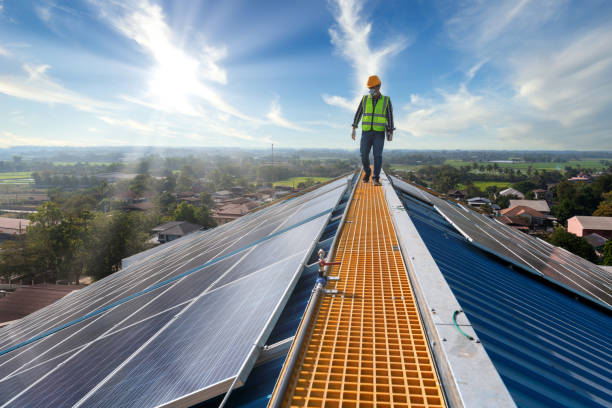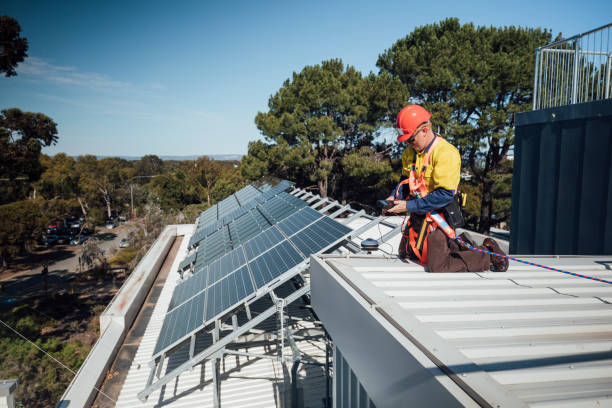ENERGY EFFICIENCY INCENTIVES FOR HVAC SYSTEMS
The Inflation Reduction Act, which became law on August 16, 2022, incentivises homeowners, building owners and contractors to install or upgrade heating and cooling systems with more energy-efficient systems to reduce greenhouse gas emissions.
Taxpayers can take advantage of three main components of the law, in addition to an energy property tax credit for non-businesses that was previously enacted. The new benefits will be available on 1 January 2023. The US Department of Energy has to figure out the application process and how to distribute funds to each state office. Combining these rebate programs is impossible, and each has its limitations. Here is a short description of each program:
The “High-Efficiency Home Rebate” program offers cash rebates to households with income restrictions for upgrades and new equipment.
The “Home Owner Managing Savings Energy (HOMES) Rebate Programme” offers more significant incentives for projects that involve the whole house, with income restrictions.
The “Energy Efficient House Improvement Tax Credit” (Section 25C) provides tax credits to install equipment that exceeds CEE’s highest tier, not the advanced tier. There are no income limitations.
There is also a Home Energy Audit Tax Credit of up to $150 per taxpayer’s primary residence
The “non-business energy property” credit tax credit under Section 25C of the previous law is extended until 31 December 2032 for property put into service after December 31st, 2021

High-Efficiency Home Rebate Program
The “High-Efficiency Electric Home Rebate Program (HEEH)” is most relevant to most homeowners. The rebate cap is as follows:
- Program Qualification Dates: Still being determined. The policy provisions for implementing HEEHRA have yet to be implemented. The IRS, EPA and DOE are federal agencies that will develop the rules and regulations to distribute the money, but individual states will directly be involved in implementing this program.
- Maximum combined rebate of $14,000
- The amount of the refund per household that qualifies:
- Energy Star-certified appliance upgrades under a qualified electrification project:
- Heat pumps for space heating and cooling can cost up to $8,000.
- Non-appliance upgrades under a qualified electrification project:
- Upgrade your electric load centre for up to $4,000
- Insulation, air sealing and ventilation can cost up to $1600
- Electrical wiring up to $2,500
- Purchased an appliance or non-appliance as part of a qualified electrification program
The main limitation is based on the household’s income. This favors low and moderate-income families. The AMI (area median income) is calculated by entering the address of the property. This calculator or website will then tell you the AMI at 80% and 100%. Multiply the 100% figure by 1.5 to calculate the threshold of 150%. This will give you the maximum household income that qualifies for the rebate program. The rebate amount is graduated according to the household income as follows:
For a household with a moderate or low income:
- If your household’s income is less than 80% of the median income in the area, you are eligible for a rebate of 100% on the system’s purchase price.
- If your household’s income falls between 80% to 150% of the median income in the area, you are eligible for a 50% rebate on the system’s purchase price.
- You are only eligible to receive the rebate if your household income is at most 150% of the median income in the area.
- Individuals or entities that own a multifamily property where at least 50 per cent of its residents are households with low or moderate incomes:
- The cost of the qualified project of electrification for a multifamily building can be at least 50% of the annual income of households that fall between 80% to 150% of the median income of the locality.
- The cost of an electrification project qualified for a multifamily structure can be at least 50% of the number of residents who are households earning less than 80% of the median annual income of their area.
A governmental, nonprofit, or commercial entity that, in the opinion of the Secretary, is carrying out an electrification project for an entity described as
- The cost of qualified electrification for a household is 50% of its total cost if the entity eligible is employed and their annual income ranges between 80% to 150% of the median income in the area.
- 100% of the cost for the electrification of a home where the household is occupied by an eligible entity and their annual income is below 80% of the median income in the area.
In the case of heating and cooling systems, “qualified electrification” means:
- Purchase and Installation of:
- Electric heat pumps for heating and cooling
- An electric load service center
- Insulation
- Improve ventilation with air-sealing materials
- Electric wiring
The project can be:
- New construction
- Replaces an appliance that is not electric (e.g. Gas, oil or coal
- A first-time purchaser of the appliance
- Energy Star certification is required for any appliance, system, infrastructure, component or related item.
- The project is being carried out in a single-family home or multifamily structure, as defined by the Secretary.

Home Owners Managing Energy Savings Rebate Program
The “HOMES rebate program” offers rebates on retrofitting whole houses to save energy that begins after August 16, 2022, and is completed before September 30, 2031. The rebate amount, similar to that offered by the “High-Efficiency Electric Home Rebate Program”, is determined based on the household’s income relative to the locality’s median income. The rebate is based on either measured or modeled energy savings. The rebate caps will be as follows:
- Single-family homeowners:
- The lower of $2,000 or half of the total project costs for a retrofit achieving modeled savings of between 20% and 35 % on an energy system.
- The lower $4,000 or half of the total project cost for an energy retrofit results in a total of over 35% of modeled system savings.
- Measured energy savings
- Energy savings must be at least 15% or higher.
- Payment rate per kilowatt-hour saved or equivalent kilowatt-hour held equal to $2,000 if the energy consumption of the average home is reduced by 20%; OR
- Project Costs: 50%
Multi-family building owners should:
For a retrofit that results in energy system savings of between 20 and 35 per cent, the maximum amount is $200,000 for multi-family buildings.
- Retrofits that result in energy system savings of greater than 35% can be retrofitted for $4,000 per unit, with a maximum amount of $400,000 per building.
- Measured energy savings
- Energy savings must be at least 15% or higher.
- Payment rate per kilowatt-hour saved or equivalent kilowatt-hour-savings, equal to $2,000, for a reduction of 20% in energy consumption per dwelling unit, for an average multi-family structure within the State.
- Project Costs: 50%
Owners of single-family homes or multifamily dwellings whose units are occupied by households with low or moderate income (greater than 50% in multifamily):
- The lower $4,000 per dwelling unit, or 80% of project costs for a retrofit, achieves energy system savings between 20% and 35 %.
- The lower $8,000 per dwelling unit, or 80% of project costs for a retrofit, achieves energy system savings of over 35%.
- Measured energy savings
- Energy savings must be at least 15% or higher.
- Payment rate per kilowatt-hour saved or equivalent kilowatt-hour held equal to $2,000 per 20% reduction in energy consumption per single-family house or dwelling unit (as applicable) for the average single-family home or multifamily building within the State.
- 80% of project costs
Energy Efficient House Improvement Tax Credit (Section 25, C)
Installing heating and cooling systems which exceed Energy Star requirements at your principal residence and installing them in your tax return is eligible for the Energy Efficient Home Improvement Tax Credit. This tax credit is open to all income levels. The current Section 25C program was extended until December 31, 2032, for a property that is placed into service after December 31 2021. The updated credit program applies to all properties placed into service after December 312022. The manufacturer must provide a serial number for any property purchased after December 31, 2024. Credits will be available up until 2032.
Individuals may receive a credit equal to 30 per cent of the total of:
- The taxpayer paid or incurred the amount for energy efficiency improvements qualified during this tax year.
- The taxpayer’s residential energy expenditures during the tax year.
- The amount that the taxpayer paid or incurred during the tax year for home energy audits.
- Tax Credit equal to 30 per cent of the costs incurred, up to:
- $1,200 annually, including:
- Air conditioners eligible for $600
- Get up to $600 off qualified furnaces
- You can get up to $600 off a natural gas, propane, oil furnace, or hot water boiler.
- Electric heat pumps: $2,000 per year for purchase
The Home Energy Audit up to $150 is for the taxpayer’s primary residence and includes the following:
The most cost-effective and significant energy efficiency improvements can be identified for a dwelling unit. This includes an estimation of energy savings and cost savings.
The audit must be conducted and prepared by an energy auditor who meets the certification or any other requirements that the Secretary specifies in regulations or guidance. (The Secretary may prescribe these requirements by 365 calendar days after the date this section was enacted).
Minimum Income Requirements
- None.
Combining programs
- It cannot be used with the “High-Efficiency Electrical Home Rebate.”
You can combine this program with other local rebates or utility rebates.

Nonbusiness Energy Property tax credit (previously implemented program)
The Inflation Reduction Act 2022 has replaced the previous program and now applies to property placed into service after December 31st 2021. Households can receive up to $300 in tax credits for the current year (2022) while waiting for the new incentives implemented on January 1, 2023. The total credits for the current year and prior years after 2005, including those for high-efficiency furnaces and air conditioners, can be at most $500.
The credit is calculated by adding 10% to the total amount of qualified energy efficiency improvement installed by the individual taxpayer AND the amount spent on residential energy property by that taxpayer in the same tax year.
The following are examples of “qualified energy properties”:
- Electric heat pumps that meet the Consortium for Energy Efficiency’s highest efficiency level as of January 1, 2009. This is 15 SEER for split systems and 14 SEER for packaged heat pumps.
- Central air conditioners that meet the Consortium for Energy Efficiency’s highest efficiency level as of January 1, 2009.
- A qualified natural gas, propane or oil furnace, or hot water boiler’s annual fuel efficiency is 95 per cent or more.
- A main circulating advanced fan used in a furnace powered by natural gas, propane or oil that uses no more than 2 per cent of its total energy consumption per year (as determined using the Department of Energy’s standard test procedures).
- The credit does not apply to rental or new construction properties. The taxpayer’s primary residence must be included.
How to Apply for Tax Credits and Rebates
You would claim the tax credits on your federal income taxes. Although we need to know which form to use, in the past, IRS Form 569 was used for similar residential energy credit programs. Good tax preparers will know which format to use, and TurboTax can guide you to the proper tax credit.
Rebate programs vary by state and will be determined in the future. Utility companies or state-run agencies could implement rebate programs. The bill includes a section that encourages state programs and the Department of Energy to work together to provide rebates at the point of purchase.
If you would like to speak with a solar electric contractor in Orlando, please call us or submit your details below.
